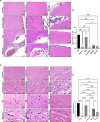Neuroprotective effects of ghrelin in cuprizone-induced rat model of multiple sclerosis
- PMID: 40214860
- PMCID: PMC11991981
- DOI: 10.1007/s11011-025-01603-z
Neuroprotective effects of ghrelin in cuprizone-induced rat model of multiple sclerosis
Abstract
Multiple sclerosis (MS) is an inflammatory central nervous system disease characterized by demyelination and axonal loss and is the main cause of non-traumatic neurological disability in young adults. Although there are several treatment approaches to manage the disease, there is no definitive cure for multiple sclerosis. Inflammation and oxidative stress are known to play important roles in the pathophysiology of MS. Ghrelin, a peptide secreted by the stomach, is reported to have neuroprotective properties through several pathways, including attenuating oxidative stress and inflammation. In the present study cuprizone (CPZ)-induced model of MS was used in Wistar albino rats to study the possible anti-inflammatory, antioxidant and neuroprotective effects of ghrelin. Rats were randomly divided into six groups: Control groups (Control35 and Control-S42), demyelination group, remyelination group, remyelination + ghrelin (20 µg/kg) group and remyelination + ghrelin (40 µg/kg) group. Y maze test was performed on the rats on their last day of the experiment. Oxidative stress and inflammatory parameters were investigated in brain using commercial kits by enzyme-linked immunosorbent assay (ELISA). Luxol fast blue (LFB) and hematoxylen&eosin (H&E) staining were performed in brain tissues. CPZ leads to a significant decrease in glutathione peroxidase (GSH-Px) levels and myelin content and a significant increase in malondialdehyde (MDA), tumor necrosis factor-alpha (TNF-ɑ), interleukin- 6 (IL- 6) levels, the number of lymphatic cells and inflammatory cells. A significant increase in the antioxidant parameter levels and a significant decrease in MDA levels were found in the ghrelin treated groups (p < 0.05). CPZ leads to irregular, fragmented, demyelinating nerve fibers. A more significant remyelination was observed in the ghrelin treated groups compared to the other groups (p < 0.05). In conclusion, ghrelin treatment showed neuroprotective and antioxidant properties and reduced demyelination in the CPZ-induced rat model of multiple sclerosis.
Keywords: Demyelination; Ghrelin; Inflammation; Neuroprotection; Oxidative stress; Remyelination.
© 2025. The Author(s).
Conflict of interest statement
Declarations. Ethics approval: The study procedures were approved by the Van Yuzuncu Yil University Ethical Committee (28/05/2020–2020/05–07). Competing interests: The authors declare no competing interests.
Figures





Similar articles
-
Coenzyme Q10 enhances remyelination and regulate inflammation effects of cuprizone in corpus callosum of chronic model of multiple sclerosis.J Mol Histol. 2021 Feb;52(1):125-134. doi: 10.1007/s10735-020-09929-x. Epub 2020 Nov 27. J Mol Histol. 2021. PMID: 33245472
-
Betaine alleviates cerebellar endoplasmic reticulum stress and oxidative imbalance in a cuprizone model of multiple sclerosis in rat.Naunyn Schmiedebergs Arch Pharmacol. 2025 Mar;398(3):2651-2664. doi: 10.1007/s00210-024-03381-4. Epub 2024 Sep 9. Naunyn Schmiedebergs Arch Pharmacol. 2025. PMID: 39249501
-
Resveratrol Promotes Remyelination in Cuprizone Model of Multiple Sclerosis: Biochemical and Histological Study.Mol Neurobiol. 2017 Jul;54(5):3219-3229. doi: 10.1007/s12035-016-9891-5. Epub 2016 Apr 11. Mol Neurobiol. 2017. PMID: 27067589
-
The roles of microglia and astrocytes in phagocytosis and myelination: Insights from the cuprizone model of multiple sclerosis.Glia. 2022 Jul;70(7):1215-1250. doi: 10.1002/glia.24148. Epub 2022 Feb 2. Glia. 2022. PMID: 35107839 Free PMC article. Review.
-
Five Decades of Cuprizone, an Updated Model to Replicate Demyelinating Diseases.Curr Neuropharmacol. 2019;17(2):129-141. doi: 10.2174/1570159X15666170717120343. Curr Neuropharmacol. 2019. PMID: 28714395 Free PMC article. Review.
References
-
- Adamo A, Paez P, Cabrera OE, Wolfson M, Franco P, Pasquini J, Soto E (2006) Remyelination after cuprizone-induced demyelination in the rat is stimulated by apotransferrin. Exp Neurol 198:519–529. 10.1016/j.expneurol.2005.12.027 - PubMed
-
- Bradford MM (1976) A rapid and sensitive method for the quantitation of microgram quantities of protein utilizing the principle of protein-dye binding. Anal Biochem 72:248–254. 10.1016/0003-2697(76)90527-3 - PubMed
-
- Brück W (2007) New insights into the pathology of multiple sclerosis: towards a unified concept? J Neurol 254:I3-I9. 10.1007/s00415-007-1002-0
MeSH terms
Substances
LinkOut - more resources
Full Text Sources
Medical

